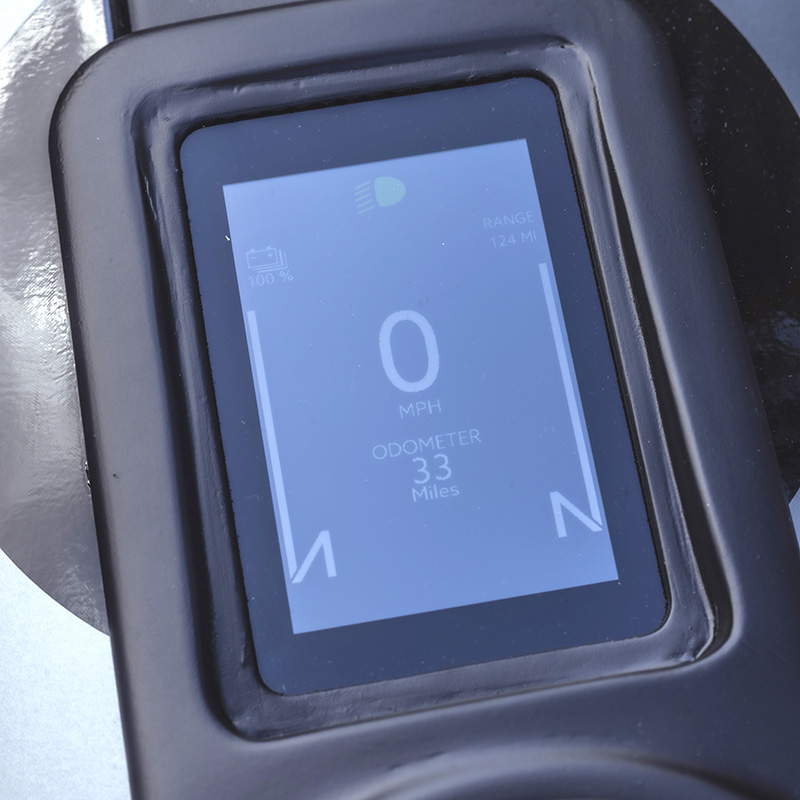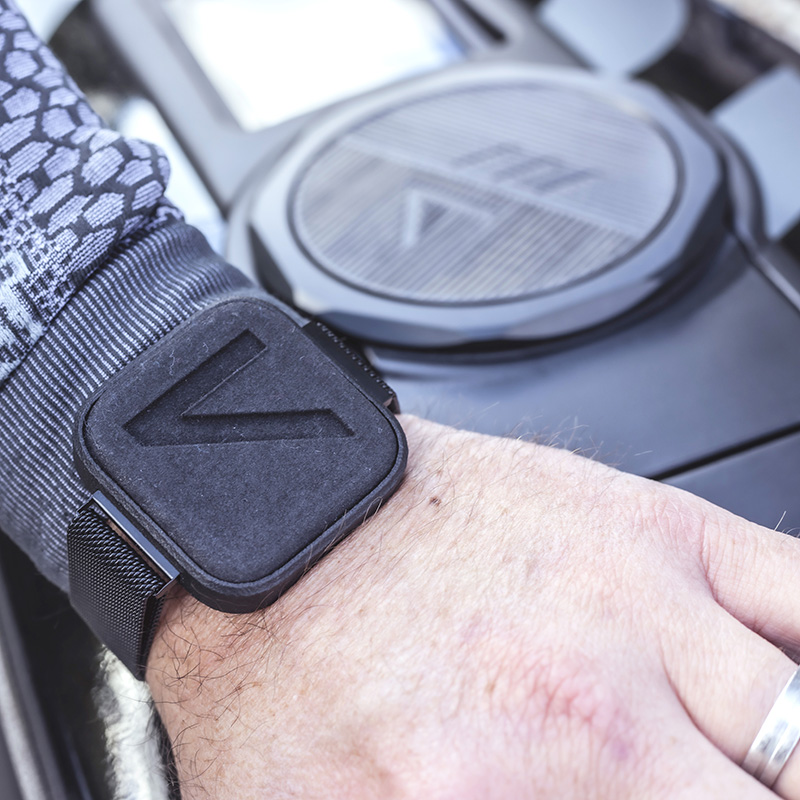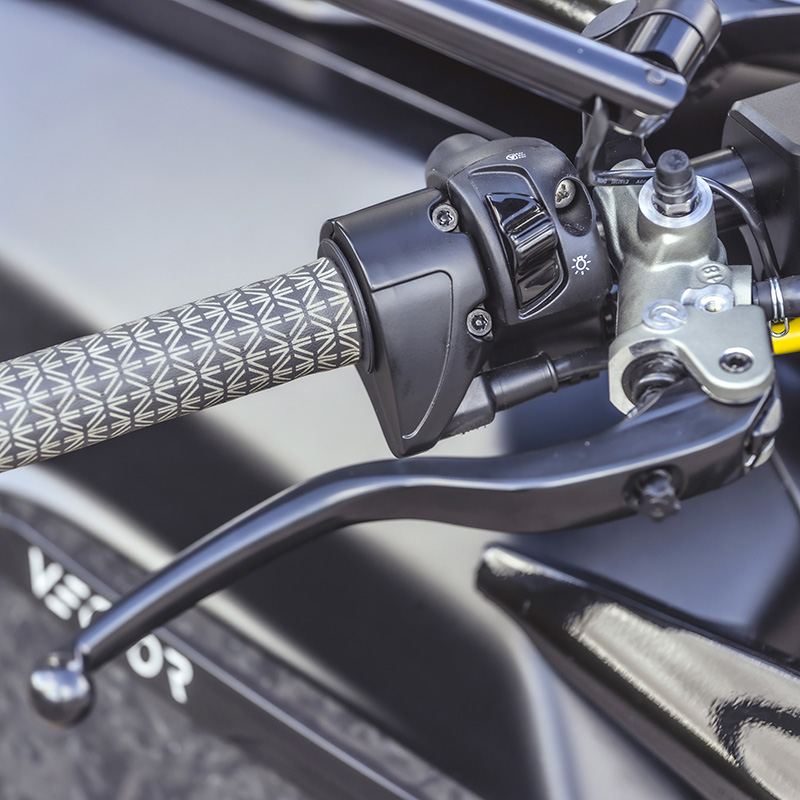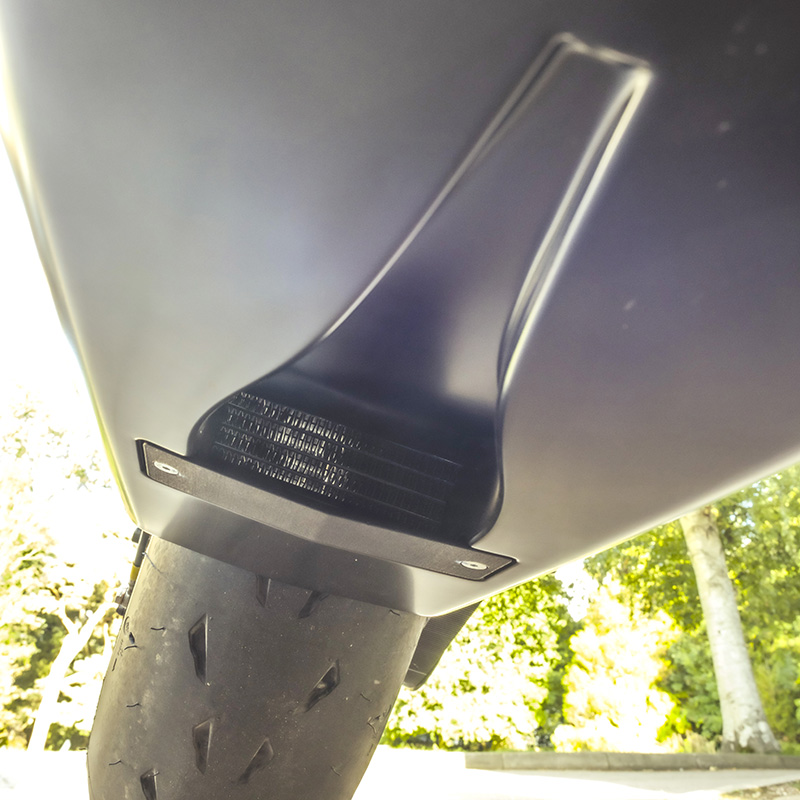Arc reckons this is the world’s most advanced motorcycle
The Arc Vector was unveiled to the public at EICMA back in 2018, dazzling the motorcycling world with its dramatic hub-centre steering and 436km of claimed range taking just 40 minutes to recharge. Most thought the Arc was an impressive concept that would fizzle away. But it’s real, it’s alive and we’ve ridden it.
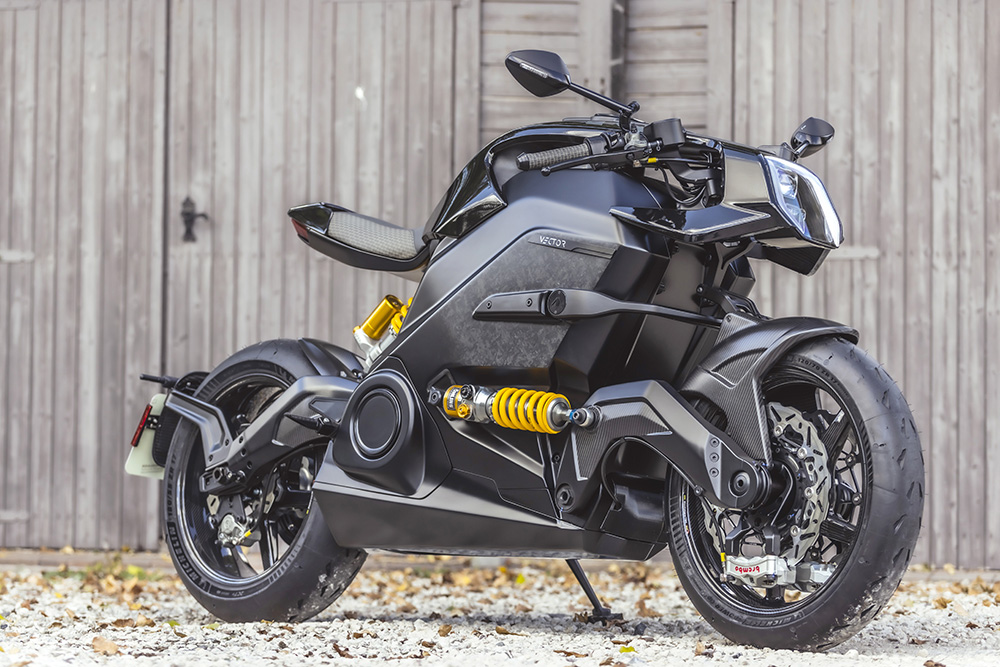
Arc motorcycles is the innovation of CEO British engineer Mark Truman, who set out to create something special: the world’s most advanced electric motorcycle. He started with a blank piece of paper, then let his imagination and brilliance run wild, free of the constrictions of noise, emissions, heat, exhaust routing and a thousand other limitations associated with petrol bikes.
Earlier this year Mark and his small team conducted the bike’s final testing, with former BSB and MotoGP racer James Ellison at the helm. With the first tailored and British-made Vectors now reaching American customers, we took one of the very first £110,000 ($200,000) bikes to leave the factory for a quick spin close to Arc HQ near Coventry in England.
The Arc is distinctive, and isn’t based on anything else in the market. There is no conventional frame; the chassis is the housing for the battery and motor, similar to Ducati’s Panigale and new MotoE racebike, but this was designed in 2018. Hub-centre steering allows a very steep head angle of 20 degrees compared to a normal sportsbike’s 24-25 degrees. The pivot point of the front shock is below the front wheel spindle, which, unlike other hub-centre steered models, allows the front to dive slightly like a conventional telescopic fork. The hub steering also allows the Arc to run a light spring at the front, which can cope with the weight (240kg) better than a conventional fork.
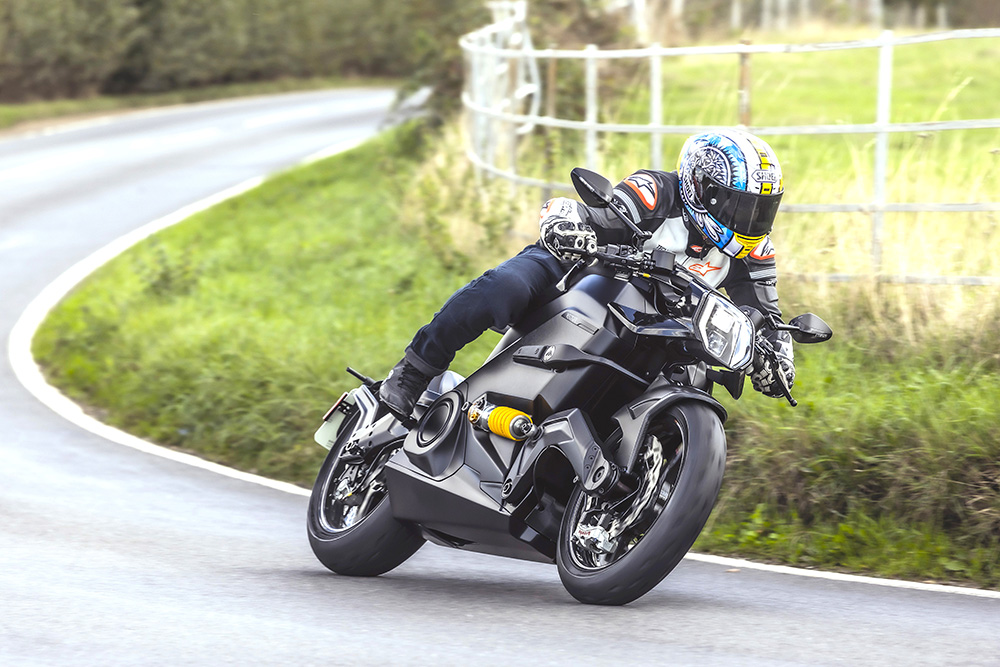
In cooperation, rear and front arms are carbon fibre, as are the BST wheels. There are Brembo Stylema calipers up front, a full carbon-fibre seat unit, keyless ignition (via a wrist strap key) and belt drive. A digital dash sits on top of the dummy fuel tank which houses the charging ports behind a fake fuel cap.
In spite of having multiple riding modes, our test bike didn’t have its finished set of rider aids installed, which will include lean-sensitive traction control and conventional ABS developed in partnership with Continental. The Arc’s permanent rare earth magnet AC motor is skilfully hidden by a blank belly pan, which houses a channel that directs cool air to the small, rear-facing radiator, which cools both the motor and inverter. The motor produces a peak of 173Nm of torque, and 87kW (117hp) of power, directed to the back wheel via a belt drive.
- The Vector only has a fast charger, which gets 90 percent of the job done in 40 minutes
- The rectangular dash can be hard to see in harsh light
The battery has a capacity of 16.8kWh (using Samsung Battery Cells) and is housed in a monocoque carbon shell, to which the front and rear bespoke carbon suspension is bolted. Arc quotes 436km on a single charge, but Mark and the team say that, realistically, around 320km could be expected during regular riding, and 190km during aggressive riding or with a motorway stint. During testing on track – with a handy James Ellison onboard – 97km was the worst recorded result, which is impressive. A normal ride on track should see, 120-140km at worst.
Top speed is limited to 200km/h, which on some tracks will be a hinderance. But Arc quotes a 0-100km/h time of 3.1 seconds – that’s quick. Recharge time from 0-90 percent is only 40 minutes on a Type 2 rapid DC fast charge, which is the only way to charge the Arc – there is no 240-volt three-pin system. In theory you could ride hard on track, charge at lunch and ride again in the afternoon. For the road, the Arc is fully road legal and meets Euro 5 compliance, which obviously isn’t as strict for electric-powered vehicles as there are no noise or emission targets to meet.
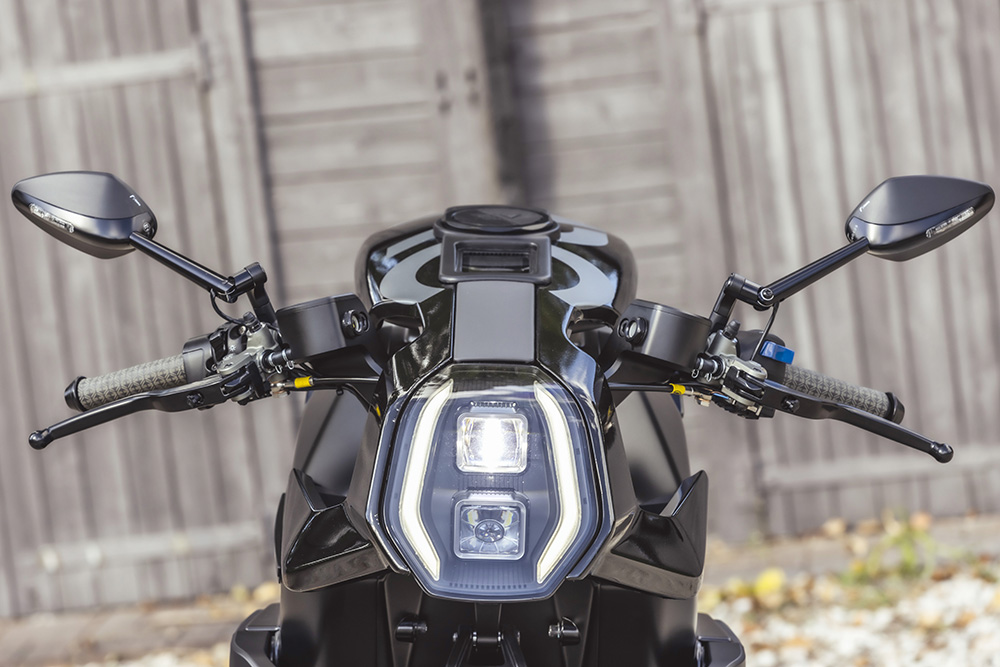
Despite spending around 30 percent of my time on electric superbikes these days, I’m still getting accustomed to riding them. Today, that initial apprehension is amplified by the value and uniqueness of the Arc. I’m the very first person outside the company allowed on the thing, and there is only one in existence. To add to my concerns, the TC and ABS have not yet been fitted, as they are still in the final throes of development.
If you’re new to electric bikes, there are no gears, of course, and the instant response of direct torque always takes a little while to get used to. Unusually, the Arc also runs a handlebar-mounted back brake, like a scooter – and very little engine braking.
Engine reaction off small throttle openings is a little abrupt compared to a petrol-powered superbike, even in Eco mode which reduces power and torque to 70 percent capability. The standard bike has three rider modes: Rain (40%), Eco (70%) and Road (100%). Once the so-called Human Machine Interface HMI (see sidebar) is completed, there will be a further three modes in Urban, Sport, and Euphoric, which will interact with your helmet and clothing.
You don’t have to wait for peak revs– acceleration is rapid – and it’s hard to stop your left foot from hunting for a gear lever as you leave the lights with Superbike performance.

From a standstill or from 50, 80, 100km/h, just twist and go. Rapidly. In wet or cold conditions, traction control will be needed. I could feel the front wheel go light on occasion over crests, but I didn’t have confidence to wheelie the Arc, it’s still unusual with not gears or clutch.
So much torque makes overtaking painless, with no changing down gears to access peak torque either. It’s a bizarre sensation passing cars with such a consummate lack of effort and no longer accompanied by an exhaust tone.
The British team has deliberately dialled-in minimal engine braking, meaning there is very little re-gen. This gives it something of a two-stroke feel that helps you roll and flow into corners. Funnily enough I ran a similar setup of minimum engine braking when I raced an electric bike at the Isle of Man TT.
Hub-centre steering isn’t new, it’s still used by Bimota on the Tesi H2, while Yamaha famously had a crack with its GTS1000 in 1993. But, as previously mentioned, the Arc system is unique from most previous designs and it all adds up to allowing for a lighter spring for the Öhlins front shock.
However, there are disadvantages, and cost is a clear one. Development was vast and expensive. Then there is the actual cost of production: the front swingarm is carbon fibre while the front mudguard, which is a structural component, is also one complete carbon unit. And they’re both bespoke items. The other disadvantage is a large turning circle that makes the Arc Vector a bit awkward in town.
- Vector continues to work on its ‘Human Machine Interface’
- Flash grips amid fairly conventional controls
But Arc’s development team knew an electric superbike would be heavy and that a hub-centre steering system, which separates the braking, steering and suspension functions would, dynamically, manage that weight better than a traditional fork – and allow a steep and sporty steering head angle. They were also unimpeded by normal design limitations: without a radiator, waterpipes, front exhaust routing and engine heat to worry about, the designers and engineers had a relatively free run at the project. Other hub-centre steered bikes have to work around heat from downpipes, cooling for the radiator, etc.
At first, the 240kg superbike does feel heavy, especially when you’re moving it around and throwing a leg over the 825mm carbon seat. Other electric bikes I’ve tested recently, which are considerably heavier, have a reverse or crawler gear, which the Arc doesn’t. I had to jump off to push backward, rather than paddle backward.
But once the carbon BST wheels are turning that weight diminishes rapidly. That steep rake angle makes the Arc feels lighter than it actually is and it took a few miles to re-calibrate as I was continuously turning too quickly and hitting the apex early, then picking up the bike and having a second stab at it. But the more I rode the Arc the more we connected, and I found myself using less input at the ’bars and ’pegs to make it turn.
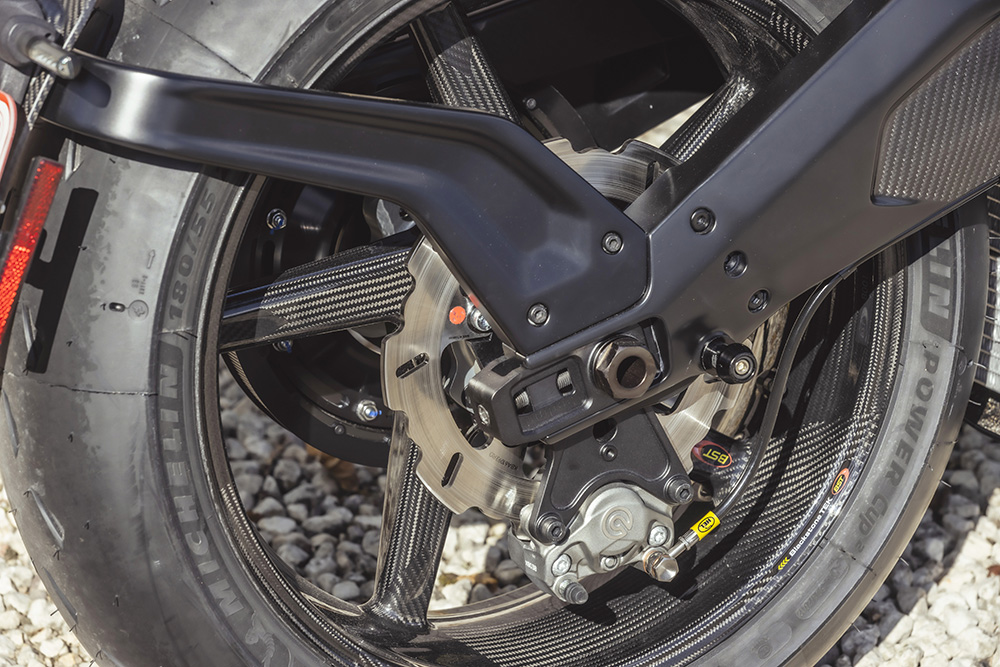
The Arc Vector steers quicker than any other electric superbike I’ve ridden, but it’s far from nervous. With suspension and braking forces separated and a relatively light spring controlling the ride, you can feel the front end reacting to bumps and imperfections – the ride is almost plush – but there isn’t a huge amount of drive or weight transfer either, and takes a while to get used to. The rear suspension uses a directly mounted Öhlins unit, which is on the hard side. You really feel this at low speeds and over imperfections around town, but once up to speed, it comes into its own.
Riding the Arc is a little like riding a racebike on the road. Generally, racebikes have less squat and suspension movement than roadbikes and that’s the same with the Vector. While that doesn’t feel great at slow speed or over large bumps and road imperfections, once you’re up to pace and putting forces through the suspension, it moves into its design window and begins to work appropriately. The Arc Vector doesn’t want to be ridden leisurely; above 80km/h is when the suspension works. Long flowing corners are its natural hunting ground and once the bike and rider are dialled in, it’s a satisfying bike to ride briskly.
But I’d avoid town; the rear is a little harsh and the steering lock is limited. Add a tall-ish seat and that instant torque as you crack open the throttle, and I can see most owners heading for the hills or track immediately. However, because each bike is bespoke, suspension and power settings can be tailored to match the customer’s requests. Theoretically, a wealthy owner who wishes to ride their Arc around Monaco rather than Phillip Island can have it tweaked to suit. The set up can also be matched to the rider’s weight and whether they’re road or track riders.
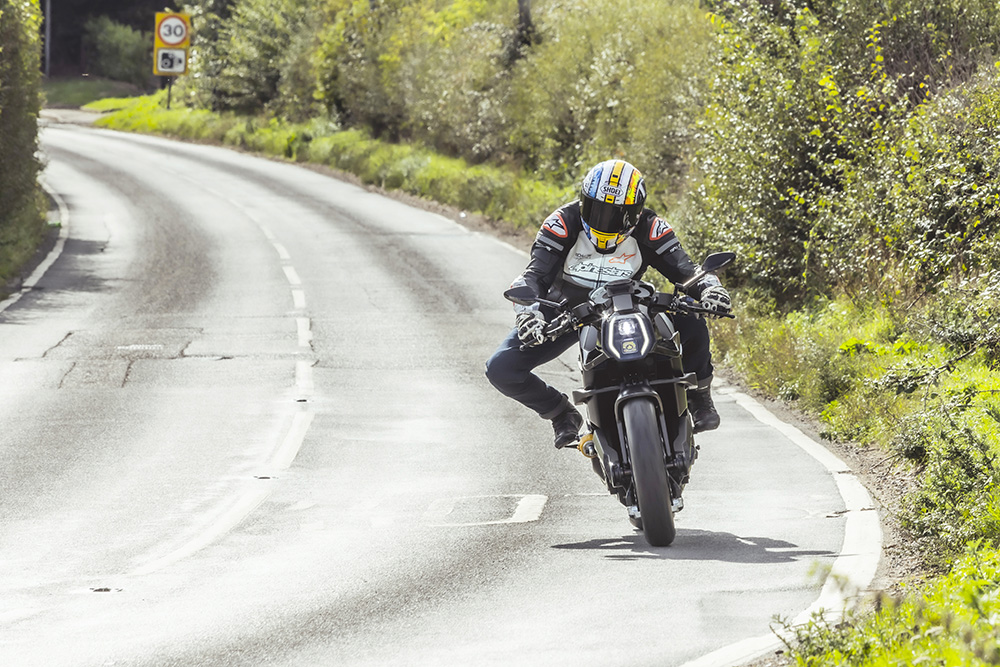
Stopping the Vector’s 235kg is down to two Brembo Stylema Monobloc calipers gripping 320mm discs. The rear is also a Brembo item, this time a 240mm disc. Once ABS is fitted, it will be possible to deactivate the ABS completely on the top-spec AE model, once you’re in Sports mode. The AE version will boast specialist machined parts and be programmed for the innovative, if not slightly controversial, Human Machine Interface (see breakout).
Decelerating takes a little getting used to, especially with so little engine braking. The front dives a little; you can feel the front tyre loading as the weight transfers forward, but not as much as conventional forks. Meanwhile the ’bar-mounted rear brake is very effective and easy to lock the rear from the lever.
Around town, I don’t think I used the front brake at all as the rear set up is so effective. It is only out of town, when you’re using all that torque and having fun, do you start to brake normally and using mainly the front. I’d really like to try the Arc on track, to push the boundaries, brake later to the apex, but as this was an early road test only, on an expensive first model, all I can truly say is that the quality Bembo items are up for the job on the road.
I’m assuming most wealthy owners aren’t going to go touring, although the range figures are impressive. After a few hours you’ll be about ready for a break and the 40 minutes it takes to recharge will be a welcome relief, comfort isn’t brilliant, especially at low speeds. It just needs personalising.
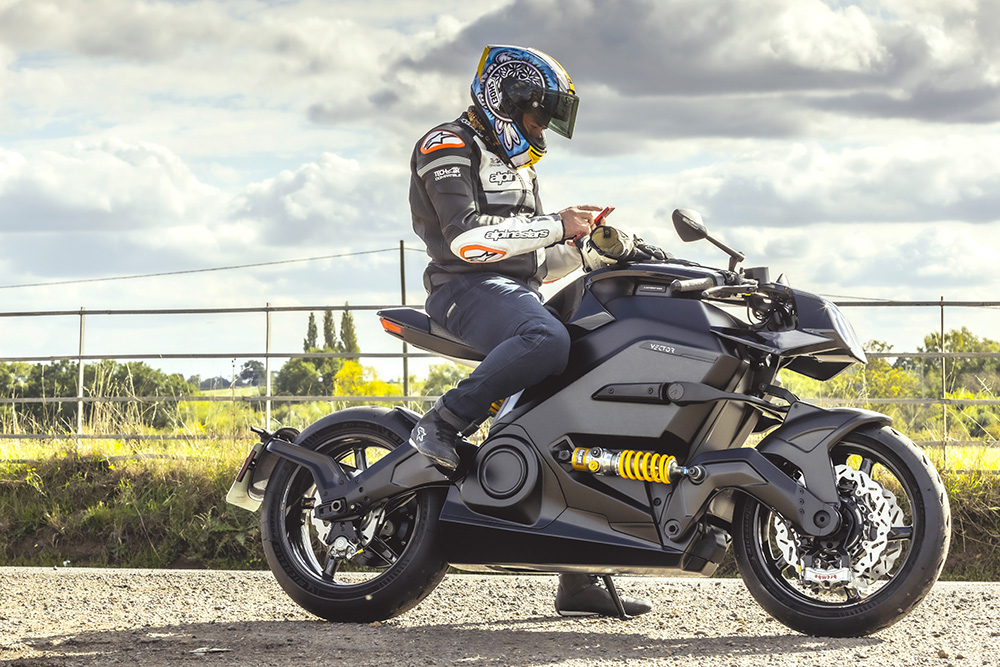
While the overall design and spec – Brembo brakes, Öhlins suspension, BST wheels – are fixed, each Vector can be customised to the rider and their demands. Colours, finish, the position of the pegs… almost everything can be matched to the owner’s personal taste. Some customers have requested black Öhlins springs instead of yellow, some have even gone for a timber-like finish on the top section – there are few limits. Customers can visit the Arc HQ or meet online to discuss materials, design, etc.
Cruise control is standard and therefore as long as you plan your road trip with a DC fast charger along the way, you could cover some decent miles on the Arc. The range and battery usage are displayed on the dash, which also shows speed, riding mode, etc. And aside from the price, this is my only real criticism, because it’s hard to see, especially when the sunlight is directly behind you. However, in the future, all the information you’ll need should be in the heads-up display in the Arc Zenith helmet (see box out).
Imagine trying to design and produce your own bike from scratch, and at the same time pushing the boundaries of design and tech. The Arc Vector is a gigantic project, one that started from nothing and has become a motorcycle that is distinctive, spectacular and very special. Its very existence is a huge achievement, which must be applauded.
- The innovative cool air channel in the belly pan
The small British team’s meticulous development of the front end has delivered a system that allows some dive, has quick steering and gives more feedback, than other hub-centre steered bikes. They’ve built a bike that uses the main battery as its chassis with both carbon swingarm bolting directly to it and a carbon mudguard that is a structural part of the bike. There’s also the forthcoming interface with a bespoke futuristic jacket and helmet. No longer hindered by the conventional architecture of petrol bikes, they have truly moved the dial in terms of design and engineering.
Not only is it uniquely designed. it works as a motorcycle. It feels misleadingly light once on the move, turns well, gives feedback, has excellent brakes – this is one quick electric superbike. Our test machine was a little firm and the initial throttle response a tad demanding, but most faults can be rectified before delivery. The clocks are a little disappointing, and you obviously can’t ignore the jaw-dropping price.
I’m assuming for actual customers, price isn’t an issue, like buying a Ferrari or Bugatti. For those privileged few who manage to grab an Arc Vector will be buying something extraordinary, not only in looks but in design and performance. When you stand back and look at what Arc has achieved, it’s impressive, which is why the orders are already coming in.

Arc Vector Specs
ENGINE
Type Permanent rare earth magnet AC motor
Controller Not given
Cooling water jacket
Transmission Single speed
Clutch Not applicable
Final drive Belt
BATTERIES
Type Lithium ion
Capacity 16.8kWh
Recharge time
Wall charge: Not applicable
DC fast charger: 90% in 40 minutes
PERFORMANCE
Power 87kW @ 1rpm(claimed)
Torque 173Nm @ 1rpm (claimed)
Top speed 200km/h (est)
Range 436km (claimed)ELECTRONICS
Type Continental
Rider aids Cornering traction 0–control and ABS
CHASSIS
Frame material Carbon
Frame layout Monocoque
Rake 20˚
Trail 105mm
SUSPENSION
Front: Öhlins ILX56 monoshock, fully adjustable, 150mm travel
Rear: Öhlins TTX56 monoshock, fully adjustable, 110mm travel
WHEELS & BRAKES
Wheels Carbon
Front: 17 x 3.5 Rear: 17 x 5.5
Tyres Pirelli Diablo Rosso 4
Front: 120/70ZR17
Rear: 180/55ZR17
Brakes Brembo
Front: Twin 320mm discs, four-piston Stylema calipers, ABS
Rear: Single 240mm disc, two-piston caliper, ABS
DIMENSIONS
Weight 240kg (claimed)
Seat height 825mm
Max width Not given
Ground clearance Not given
Wheelbase 1450mm
SERVICE & WARRANTY
First service Not given
Minor: Not given
Major: Not given
Warranty Not given
BUSINESS END
Price £110,000 ($198,000)
Colour options Any
Contact arcvehicle.com

